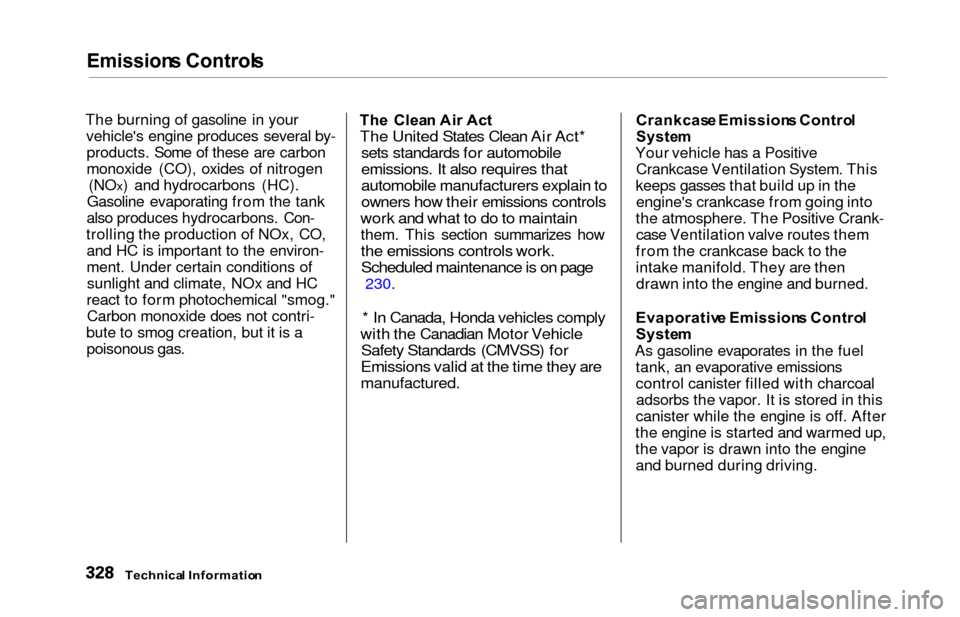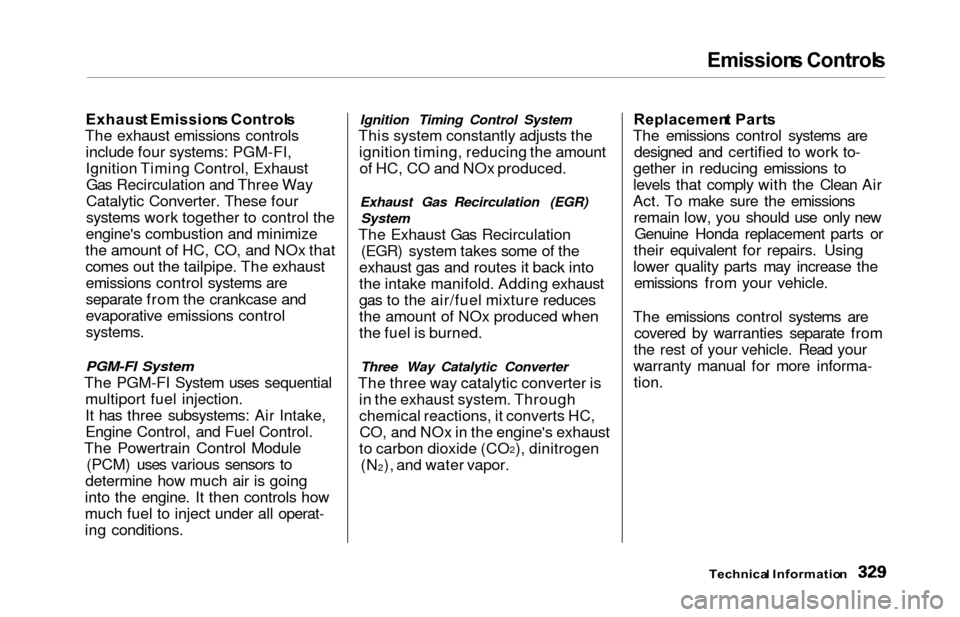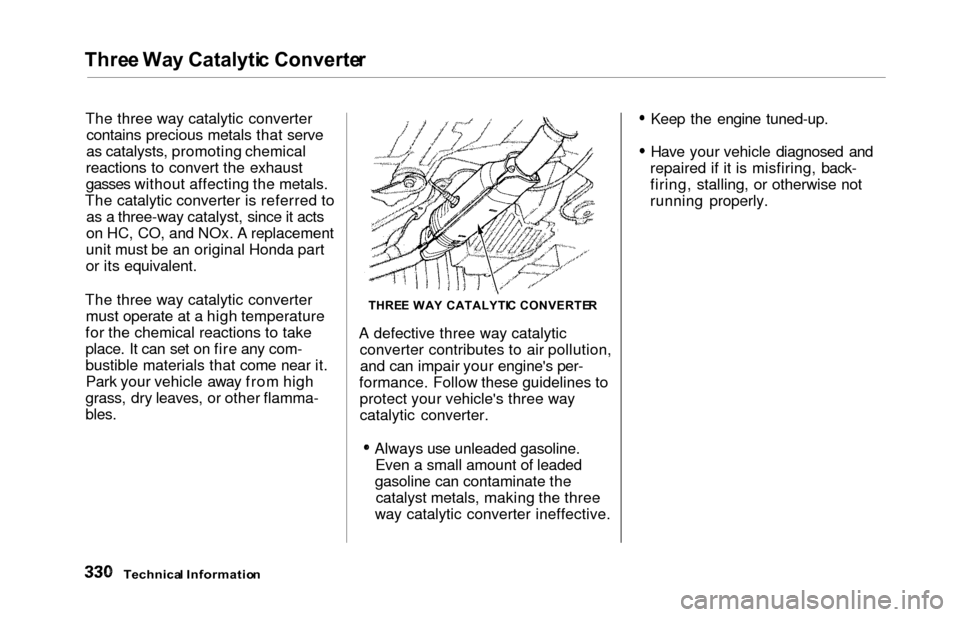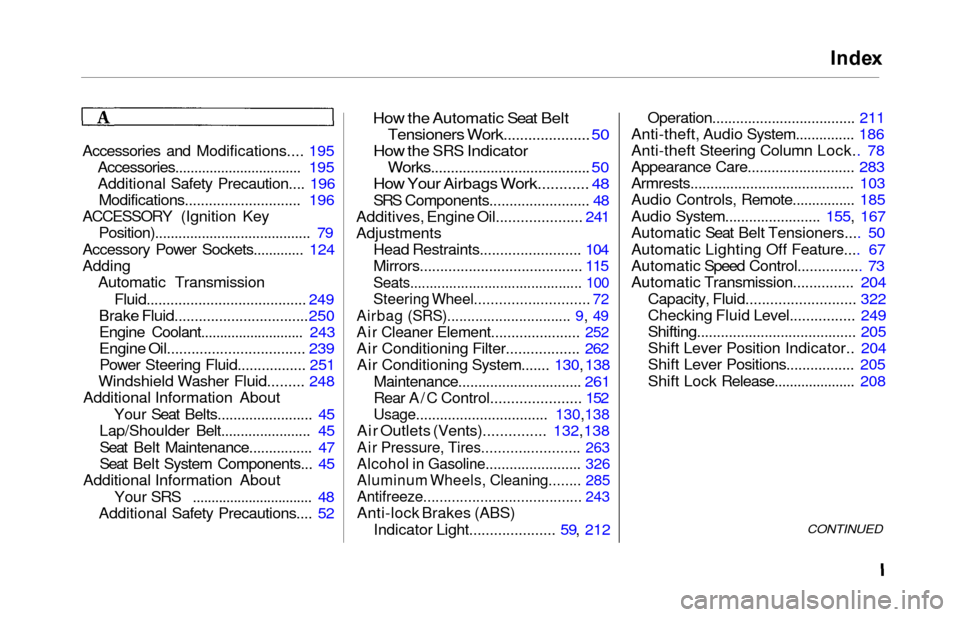Page 323 of 352
Identification Number s
Your vehicle has several identifying
numbers located in various places.
The Vehicle Identification Number (VIN) is the 17-digit number your
Honda dealer uses to register your
vehicle for warranty purposes. It is also necessary for licensing and
insuring your vehicle. The easiest
place to find the VIN is on a plate
fastened to the top of the dashboard.
You can see it by looking through the windshield on the driver's side. Itis also on the Certification label at-
tached to the driver's doorjamb, and is stamped on the engine com-
partment bulkhead. The VIN is also provided in bar code on the Certification label.VEHICL E IDENTIFICATIO N NUMBE R
CERTIFICATIO N LABE L
Technica l Informatio n
Page 324 of 352
Identification Number s
The Engine Number is stamped into
the engine block. It is on the front.
The Transmission Number is on a label on top of the transmission.
ENGIN E NUMBE R
AUTOMATI C TRANSMISSIO N NUMBE R
Technica l Informatio n
Page 325 of 352
Specifications
* 1 : Including the coolant in the reserve tank and that remaining in theengine.Reserve tank capacity:0.16 US gal (0.6 ,0.13 Imp gal)
* 2 : Excluding the oil remaining in the engine.
Technical Informatio n
*1 : LX*2: EX
Page 331 of 352

Emissions Control s
The burning of gasoline in your
vehicle's engine produces several by-products. Some of these are carbon
monoxide (CO), oxides of nitrogen (NO
x) and hydrocarbons (HC).
Gasoline evaporating from the tank
also produces hydrocarbons. Con-
trolling the production of NOx, CO, and HC is important to the environ-
ment. Under certain conditions ofsunlight and climate, NOx and HC
react to form photochemical "smog." Carbon monoxide does not contri-
bute to smog creation, but it is a
poisonous gas.
Th e Clea n Ai r Ac t
The United States Clean Air Act*
sets standards for automobile
emissions. It also requires that
automobile manufacturers explain to
owners how their emissions controls
work and what to do to maintain
them. This section summarizes how
the emissions controls work.
Scheduled maintenance is on page
230.
* In Canada, Honda vehicles comply
with the Canadian Motor Vehicle
Safety Standards (CMVSS) for
Emissions valid at the time they are
manufactured.
Crankcas e Emission s Contro l
System
Your vehicle has a Positive
Crankcase Ventilation System. This
keeps gasses that build up in the engine's crankcase from going into
the atmosphere. The Positive Crank- case Ventilation valve routes them
from the crankcase back to the
intake manifold. They are then drawn into the engine and burned.
Evaporativ e Emission s Contro l
Syste m
As gasoline evaporates in the fuel tank, an evaporative emissions
control canister filled with charcoaladsorbs the vapor. It is stored in this
canister while the engine is off. After
the engine is started and warmed up,
the vapor is drawn into the engine and burned during driving.
Technica l Informatio n
Page 332 of 352

Emissions Control s
Exhaus t Emission s Control s
The exhaust emissions controls include four systems: PGM-FI,
Ignition Timing Control, ExhaustGas Recirculation and Three Way
Catalytic Converter. These four
systems work together to control the
engine's combustion and minimize
the amount of HC, CO, and NOx that
comes out the tailpipe. The exhaust emissions control systems are
separate from the crankcase and
evaporative emissions control
systems.
PGM-FI System
The PGM-FI System uses sequential multiport fuel injection.
It has three subsystems: Air Intake,
Engine Control, and Fuel Control.
The Powertrain Control Module (PCM) uses various sensors to
determine how much air is going
into the engine. It then controls how
much fuel to inject under all operat-
ing conditions.
Ignition Timing Control System
This system constantly adjusts the ignition timing, reducing the amountof HC, CO and NOx produced.
Exhaust Gas Recirculation (EGR)
System
The Exhaust Gas Recirculation (EGR) system takes some of the
exhaust gas and routes it back into
the intake manifold. Adding exhaust
gas to the air/fuel mixture reduces
the amount of NOx produced when
the fuel is burned.
Three Way Catalytic Converter
The three way catalytic converter is in the exhaust system. Through
chemical reactions, it converts HC,CO, and NOx in the engine's exhaust
to carbon dioxide (CO
2), dinitrogen
(N
2), and water vapor. Replacemen
t Part s
The emissions control systems are designed and certified to work to-
gether in reducing emissions to
levels that comply with the Clean Air
Act. To make sure the emissions remain low, you should use only newGenuine Honda replacement parts or
their equivalent for repairs. Using
lower quality parts may increase the emissions from your vehicle.
The emissions control systems are covered by warranties separate from
the rest of your vehicle. Read your
warranty manual for more informa- tion.
Technica l Informatio n
Page 333 of 352

Three Wa y Catalyti c Converte r
The three way catalytic converter
contains precious metals that serve
as catalysts, promoting chemical
reactions to convert the exhaust
gasses without affecting the metals.
The catalytic converter is referred to as a three-way catalyst, since it acts
on HC, CO, and NOx. A replacement
unit must be an original Honda part
or its equivalent.
The three way catalytic converter must operate at a high temperature
for the chemical reactions to take
place. It can set on fire any com-
bustible materials that come near it. Park your vehicle away from high
grass, dry leaves, or other flamma-
bles.
A defective three way catalytic converter contributes to air pollution,and can impair your engine's per-
formance. Follow these guidelines to protect your vehicle's three way
catalytic converter.
Always use unleaded gasoline.Even a small amount of leaded
gasoline can contaminate the catalyst metals, making the three
way catalytic converter ineffective. Keep the engine tuned-up.
Have your vehicle diagnosed and
repaired if it is misfiring, back-
firing, stalling, or otherwise not
running properly.
Technica l Informatio n
THREE WA Y CATALYTI C CONVERTE R
Page 341 of 352
Authorize
d Manual s
These Publications cannot be returned for credit without receiving advance authorization within 14 days of delivery. On returns, a restocking fee may be applied against the original order.
P.O. BOX 07280 DETROIT, MICHIGAN 48207 1-800-782-4356
Servic
e Manual :
This manual covers maintenance and recommended procedures for repair to engine and chassis components.
It is written for the Journeyman mechanic, but is simple
enough for most mechanically-inclined owners to under-
stand.
Electrica l Troubleshootin g Manual :
This manual complements the Service Manual by providing in-depth troubleshooting information for each
electrical circuit in your vehicle.
Bod y Repai r Manual :
This manual describes the procedures involved in the replacement of damaged body parts.
Page 342 of 352

Index
Accessories and Modifications.... 195
Accessories................................. 195
Additional Safety Precaution.... 196
Modifications............................. 196
ACCESSORY (Ignition Key Position)........................................ 79
Accessory Power Sockets............. 124
Adding Automatic Transmission
Fluid........................................ 249
Brake Fluid................................. 250
Engine Coolant........................... 243
Engine Oil.................................. 239
Power Steering Fluid................. 251
Windshield Washer Fluid......... 248
Additional Information About
Your Seat Belts........................ 45
Lap/Shoulder Belt....................... 45
Seat Belt Maintenance................ 47
Seat Belt System Components... 45
Additional Information About
Your SRS ................................
48
Additional Safet
y Precautions.... 52
How the Automatic Seat Belt
Tensioners Work..................... 50
How the SRS Indicator
Works........................................ 50
How Your Airbags Work............ 48
SRS Components......................... 48
Additives, Engine Oil..................... 24 1
Adjustments Head Restraints......................... 104
Mirrors........................................ 115
Seats............................................ 100
Steering Wheel............................ 72
Airbag (SRS)............................... 9, 4 9
Air Cleaner Element...................... 252
Air Conditioning Filter.................. 262
Air Conditioning System....... 130, 138
Maintenance............................... 261
Rear A/C Control...................... 152
Usage................................. 130, 138
Air Outlets (Vents)............... 132, 138
Air Pressure, Tires........................ 263
Alcohol in Gasoline........................ 326
Aluminum Wheels, Cleaning........ 285
Antifreeze....................................... 243
Anti-lock Brakes (ABS)
Indicator Light..................... 59 , 212Operation.................................... 211
Anti-theft, Audio System............... 186
Anti-theft Steering Column Lock.. 78
Appearance Care........................... 283
Armrests........................................ . 103
Audio Controls, Remote................ 185
Audio System........................ 155, 167
Automatic Seat Belt Tensioners.... 50
Automatic Lighting Off Feature.... 67
Automatic Speed Control................ 73
Automatic Transmission............... 204
Capacity, Fluid........................... 322
Checking Fluid Level................ 249
Shifting........................................ 205
Shift Lever Position Indicator.. 204
Shift Lever Positions................. 205
Shift Lock Release..................... 208CONTINUED